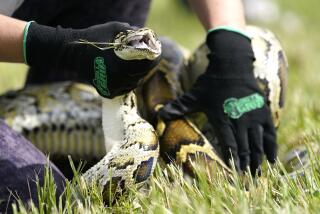Officials fear African python invading Florida’s Everglades
- Share via
FORT LAUDERDALE, FLA. — The largest snake in Africa, a powerful constrictor that consumes goats, wart hogs and crocodiles, has been found east of the Everglades, raising the possibility that it is breeding in the wild in a state already overrun with nonnative wildlife.
Authorities are investigating the discovery of three African rock pythons, including a juvenile and a female with eggs, in Miami-Dade County over the last few months.
Although state wildlife officials hope these were simply released pets, they are taking seriously the danger that the African rock python has established itself alongside another nonnative constrictor, the Burmese python, now estimated to number in the thousands in Everglades National Park.
The Florida Fish and Wildlife Conservation Commission plans to send officers to the area where the snakes were found this summer.
“We’re not sure whether it’s someone releasing them or not,” said Scott Hardin, exotic species coordinator for the state wildlife commission. “It’s enough to be concerned.”
Experts say the danger to people is remote, but there have been fatal attacks. A 10-year-old boy was killed and eaten by an African rock python in 2002 in South Africa. And in 1999 a pet African rock python in Centralia, Ill., slipped out of its enclosure and strangled a 3-year-old boy.
A more realistic danger is to South Florida’s environment, where nonnative species can consume wildlife, displace native predators and cause unpredictable changes to already stressed wild lands.
Lt. Lisa Wood of the Miami-Dade Fire Rescue Venom Response Team found two of the snakes. One night in late May, while investigating a report of a giant snake, she found a female about 9 feet long injured by a vehicle. The snake contained about three dozen eggs.
“Had she made it across the road, there would have been quite a lot of babies hatched,” Wood said.
In August, in another indication that the snakes may be breeding, Wood found a 28-inch juvenile that had been shot with a BB gun. It was still bulging from a recently consumed bird.
The African rock python is found on dry land near lakes and streams in Africa south of the Sahara. It can grow longer than 20 feet, although specimens of 16 feet are more typical.
In the last five years, 3,158 African rock pythons have been imported into the U.S. for commercial sales, according to the U.S. Fish and Wildlife Service. The snake is known to be aggressive and is far less popular as a pet than other constrictors, such as the smaller, mild-tempered ball python, of which 619,488 were imported, or the smaller Burmese, of which 19,817 were brought in.
Greg Graziani, a Central Florida reptile breeder, said the Miami-Dade area where the rock pythons were found seemed too densely populated to conceal a breeding population of such large reptiles.
“When you’re talking about a breeding population, you’re talking about large snakes,” he said. “When they’re large enough to be breeders, they’re going to be seen.”
There’s a chance the Burmese and African rock pythons could mate, because the two species have produced offspring in captivity, said Bill Turner, a biologist with the state wildlife commission. Such a hybrid could be a tougher animal than either of the pure breeds, he said, but it would almost certainly be sterile.
The Burmese python has come to symbolize the danger that is present when nonnative species establish a self-sustaining population in the Everglades. The snakes eat wading birds, raccoons, deer and other native wildlife.
The state wildlife commission now requires that Burmese pythons, African rock pythons and several other snakes have microchips implanted to prevent owners from abandoning them. And Congress is considering legislation that would ban the import and interstate transport of the two species of snakes.
--
--
BEGIN TEXT OF INFOBOX
The African rock python
Length: Adults average 16 feet, but can grow to more than 20 feet
Prey: Gazelles, wart hogs, monkeys, rats, birds, small Nile crocodiles
Hunting: Uses heat-receptive cells on upper lip to detect warm-blooded prey, even in darkness. Strikes with back-curved teeth and coils around prey.
Habitat: Grasslands and forests near water in sub-Saharan Africa
Source: Reptiles and Amphibians of Southern Africa, South Florida Sun-Sentinel
More to Read
Sign up for Essential California
The most important California stories and recommendations in your inbox every morning.
You may occasionally receive promotional content from the Los Angeles Times.













